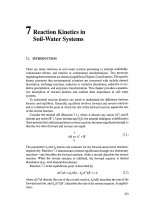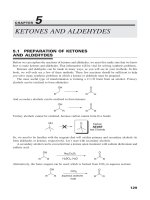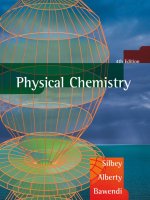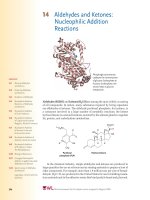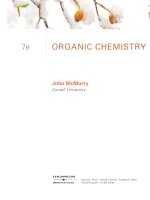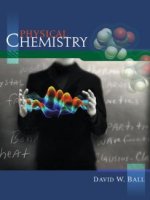Ebook General chemistry The essential concepts Part 2
Bạn đang xem bản rút gọn của tài liệu. Xem và tải ngay bản đầy đủ của tài liệu tại đây (2.88 MB, 20 trang )
cha75632_ch11_363-398.indd Page 363 9/16/09 9:15:04 PM user-s180
/Volumes/MHDQ-New/MHDQ144/MHDQ144-11
CHAPTER
11
HO
H
N
O
CH 3
O
The burning sensation of chili peppers such as habaneros is mostly
due to the organic compound capsaicin (illustrated by its skeletal
structure).
Introduction to
Organic Chemistry
CHAPTER OUTLINE
ESSENTIAL CONCEPTS
11.1 Classes of Organic Compounds 364
11.2 Aliphatic Hydrocarbons 364
Organic Compounds Organic compounds contain primarily
carbon and hydrogen atoms, plus nitrogen, oxygen, sulfur, and
atoms of other elements. The parent compounds of all organic
compounds are the hydrocarbons—the alkanes (containing only
single bonds), the alkenes (containing carbon-carbon double
bonds), the alkynes (containing carbon-carbon triple bonds), and
the aromatic hydrocarbons (containing the benzene ring).
Functional Groups The reactivity of organic compounds can
be reliably predicted by the presence of functional groups, which
are groups of atoms that are largely responsible for the chemical
behavior of the compounds.
Chirality Certain organic compounds can exist as nonsuperimposable mirror-image twins. These compounds are said to be
chiral. The pure enantiomer of a compound can rotate planepolarized light. Enantiomers have identical physical properties
but exhibit different chemical properties toward another chiral
substance.
Alkanes • Cycloalkanes • Alkenes • Alkynes
11.3 Aromatic Hydrocarbons 379
Nomenclature of Aromatic Compounds •
Properties and Reactions of Aromatic Compounds
11.4 Chemistry of the Functional Groups 382
Alcohols • Ethers • Aldehydes and Ketones • Carboxylic Acids
• Esters • Amines • Summary of Functional Groups
11.5 Chirality—The Handedness of Molecules 389
STUDENT INTERACTIVE ACTIVITIES
Animations
Chirality (11.5)
Electronic Homework
Example Practice Problems
End of Chapter Problems
363
cha75632_ch11_363-398.indd Page 364 9/16/09 9:15:23 PM user-s180
364
1A
H 2A
CHAPTER 11
/Volumes/MHDQ-New/MHDQ144/MHDQ144-11
Introduction to Organic Chemistry
8A
3A 4A 5A 6A 7A
B C N O F
Si P S Cl
Br
I
Common elements in organic
compounds.
11.1 Classes of Organic Compounds
Carbon can form more compounds than most other elements because carbon atoms
are able not only to form single, double, and triple carbon-carbon bonds, but also to
link up with each other in chains and ring structures. The branch of chemistry that
deals with carbon compounds is organic chemistry.
Classes of organic compounds can be distinguished according to functional groups
they contain. A functional group is a group of atoms that is largely responsible for the
chemical behavior of the parent molecule. Different molecules containing the same kind
of functional group or groups undergo similar reactions. Thus, by learning the characteristic properties of a few functional groups, we can study and understand the properties of many organic compounds. In the second half of this chapter we will discuss the
functional groups known as alcohols, ethers, aldehydes and ketones, carboxylic acids,
and amines.
All organic compounds are derived from a group of compounds known as
hydrocarbons because they are made up of only hydrogen and carbon. On the basis
of structure, hydrocarbons are divided into two main classes—aliphatic and aromatic.
Aliphatic hydrocarbons do not contain the benzene group, or the benzene ring,
whereas aromatic hydrocarbons contain one or more benzene rings.
11.2 Aliphatic Hydrocarbons
Aliphatic hydrocarbons are divided into alkanes, alkenes, and alkynes, discussed in
this section (Figure 11.1).
Alkanes
For a given number of carbon atoms, the
saturated hydrocarbon contains the largest number of hydrogen atoms.
Alkanes are hydrocarbons that have the general formula CnH2n12, where n 5 1,
2, . . . . The essential characteristic of alkanes is that only single covalent bonds are
present. The alkanes are known as saturated hydrocarbons because they contain the
maximum number of hydrogen atoms that can bond with the number of carbon atoms
present.
The simplest alkane (that is, with n 5 1) is methane CH4, which is a natural product
of the anaerobic bacterial decomposition of vegetable matter under water. Because it was
first collected in marshes, methane became known as “marsh gas.” A rather improbable
Figure 11.1
Classification of hydrocarbons.
Hydrocarbons
Aromatic
Aliphatic
Alkanes
Cycloalkanes
Alkenes
Alkynes
cha75632_ch11_363-398.indd Page 365 9/16/09 9:15:27 PM user-s180
/Volumes/MHDQ-New/MHDQ144/MHDQ144-11
11.2 Aliphatic Hydrocarbons
365
Figure 11.2
H
A
H O CO H
A
H
H H
A A
HOC OC OH
A A
H H
H H H
A A A
HOC OC OC OH
A A A
H H H
Methane
Ethane
Propane
H H H H
A A A A
HOC OCO COC OH
A A A A
H H H H
H
A
HOC OH
A
H A H
A A A
HO C OC OCOH
A A A
H H H
n-Butane
Isobutane
Structures of the first four
alkanes. Note that butane can
exist in two structurally different
forms, called structural isomers.
but proven source of methane is termites. When these voracious insects consume wood,
the microorganisms that inhabit their digestive system break down cellulose (the major
component of wood) into methane, carbon dioxide, and other compounds. An estimated
170 million tons of methane are produced annually by termites! It is also produced in
some sewage treatment processes. Commercially, methane is obtained from natural gas.
Figure 11.2 shows the structures of the first four alkanes (n 5 1 to n 5 4). Natural gas is a mixture of methane, ethane, and a small amount of propane. We discussed
the bonding scheme of methane in Chapter 10. The carbon atoms in all the alkanes can
be assumed to be sp3-hybridized. The structures of ethane and propane are straightforward, for there is only one way to join the carbon atoms in these molecules. Butane,
however, has two possible bonding schemes resulting in different compounds called
n-butane (n stands for normal) and isobutane. n-Butane is a straight-chain alkane because
the carbon atoms are joined in a continuous chain. In a branched-chain alkane like
isobutane, one or more carbon atoms are bonded to a nonterminal carbon atom. Isomers
that differ in the order in which atoms are connected are called structural isomers.
In the alkane series, as the number of carbon atoms increases, the number of structural
isomers increases rapidly. For example, C4H10 has two isomers; C10H22 has 75 isomers;
and C30H62 has over 400 million possible isomers! Obviously, most of these isomers do
not exist in nature nor have they been synthesized. Nevertheless, the numbers help to
explain why carbon is found in so many more compounds than any other element.
Termites are a natural source of
methane.
EXAMPLE 11.1
How many structural isomers can be identified for pentane, C5H12?
Strategy For small hydrocarbon molecules (eight or fewer C atoms), it is relatively
easy to determine the number of structural isomers by trial and error.
Solution The first step is to write the straight-chain structure:
H H H H H
A A A A A
HOCOCOCOCOCOH
A A A A A
H H H H H
n-pentane
(b.p. 36.1°C)
(Continued)
n-pentane
cha75632_ch11_363-398.indd Page 366 9/16/09 9:15:32 PM user-s180
366
CHAPTER 11
/Volumes/MHDQ-New/MHDQ144/MHDQ144-11
Introduction to Organic Chemistry
The second structure, by necessity, must be a branched chain:
H CH3 H H
A A
A A
HOCOCO
C OOCOCOH
A A
A A
H H
H H
2-methylbutane
(b.p. 27.9°C)
2-methylbutane
Yet another branched-chain structure is possible:
H CH3 H
A
A A
HOCOCOOOCOH
A
A A
H CH3 H
2,2-dimethylpropane
(b.p. 9.5°C)
2,2-dimethylpropane
Similar problems: 11.11, 11.12.
We can draw no other structure for an alkane having the molecular formula C5H12.
Thus, pentane has three structural isomers, in which the numbers of carbon and hydrogen
atoms remain unchanged despite the differences in structure.
Practice Exercise How many structural isomers are there in the alkane C6H14?
Table 11.1 shows the melting and boiling points of the straight-chain isomers of
the first 10 alkanes. The first four are gases at room temperature; and pentane through
decane are liquids. As molecular size increases, so does the boiling point.
Drawing Chemical Structures
Shortly we will discuss the nomenclature
of alkanes.
Before proceeding further, it is useful to learn different ways of drawing the structure
of organic compounds. Consider the alkane 2-methylbutane (C5H12). To see how atoms
are connected in this molecule, we need to first write a more detailed molecular formula,
Table 11.1
Crude oil is the source of many
hydrocarbons.
The First 10 Straight-Chain Alkanes
Name of
Hydrocarbon
Molecular
Formula
Methane
CH4
Ethane
Number of
Carbon
Atoms
Melting
Point (°C)
Boiling
Point (°C)
1
2182.5
2161.6
CH3OCH3
2
2183.3
288.6
Propane
CH3OCH2OCH3
3
2189.7
242.1
Butane
CH3O(CH2)2OCH3
4
2138.3
20.5
Pentane
CH3O(CH2)3OCH3
5
2129.8
36.1
Hexane
CH3O(CH2)4OCH3
6
295.3
68.7
Heptane
CH3O(CH2)5OCH3
7
290.6
98.4
Octane
CH3O(CH2)6OCH3
8
256.8
125.7
Nonane
CH3O(CH2)7OCH3
9
253.5
150.8
Decane
CH3O(CH2)8OCH3
10
229.7
174.0
cha75632_ch11_363-398.indd Page 367 9/16/09 9:15:35 PM user-s180
/Volumes/MHDQ-New/MHDQ144/MHDQ144-11
11.2 Aliphatic Hydrocarbons
H
A
HOCOH
C
A
H A H H
A A A A
HOCOCOCOCOH
C C C C
A A A A
H H H H
CH3
A
CH
CH
D G
D 3
H3C
CH2
(a)
(b)
(c)
(d)
367
Figure 11.3
CH3CH(CH3)CH2CH3, and then draw its structural formula, shown in Figure 11.3(a).
While informative, this structure is time-consuming to draw. Therefore, chemists have
devised ways to simplify the representation. Figure 11.3(b) is an abbreviated version
and the structure shown in Figure 11.3(c) is called the skeletal structure in which all
the C and H letters are omitted. A carbon atom is assumed to be at each intersection
of two lines (bonds) and at the end of each line. Because every C atom forms four
bonds, we can always deduce the number of H atoms bonded to any C atom. One of
the two end CH3 groups is represented by a vertical line. What is lacking in these
structures, however, is the three-dimensionality of the molecule, which is shown by the
molecular model in Figure 11.3(d). Depending on the purpose of discussion, any of
these representations can be used to describe the properties of the molecule.
Conformation of Ethane
Molecular geometry gives the spatial arrangement of atoms in a molecule. However,
atoms are not held rigidly in position because of internal molecular motions. For this
reason, even a simple molecule like ethane may be structurally more complicated than
we think.
The two C atoms in ethane are sp3-hybridized and they are joined by a sigma
bond (see Section 10.5). Sigma bonds have cylindrical symmetry, that is, the overlap of the sp3 orbitals is the same regardless of the rotation of the COC bond. Yet
this bond rotation is not totally free because of the interactions between the H atoms
on different C atoms. Figure 11.4 shows the two extreme conformations of ethane.
Conformations are different spatial arrangements of a molecule that are generated
by rotation about single bonds. In the staggered conformation, the three H atoms
on one C atom are pointing away from the three H atoms on the other C atom,
whereas in the eclipsed conformation the two groups of H atoms are aligned parallel to one another.
A simpler and effective way of viewing these two conformations is by using the
Newman projection, also shown in Figure 11.4. Look at the COC bond end-on. The
two C atoms are represented by a circle. The COH bonds attached to the front C
atom are the lines going to the center of the circle, and the COH bonds attached to
the rear C atom appear as lines going to the edge of the circle. The eclipsed form of
ethane is less stable than the staggered form. Figure 11.5 shows the variation in the
potential energy of ethane as a function of rotation. The rotation of one CH3 group
relative to the other is described in terms of the angle between the COH bonds on
Different representations of
2-methylbutane. (a) Structural
formula. (b) Abbreviated
formula. (c) Skeletal formula.
(d) Molecular model.
Skeletal structure is the simplest structure. Atoms other than C and H must be
shown explicitly in a skeletal structure.
cha75632_ch11_363-398.indd Page 368 9/16/09 9:15:38 PM user-s180
368
CHAPTER 11
/Volumes/MHDQ-New/MHDQ144/MHDQ144-11
Introduction to Organic Chemistry
Figure 11.4
Molecular models and Newman
projections of the staggered and
eclipsed conformations of ethane.
The dihedral angle in the
staggered form is 60° and that
in the eclipsed form is 0°. The
COC bond is rotated slightly
in the Newman projection of the
eclipsed form in order to show
the H atoms attached to the back
C atom. The proximity of the H
atoms on the two C atoms in the
eclipsed form results in a greater
repulsion, and hence its instability
relative to the staggered form.
Staggered
conformation
Eclipsed
conformation
H
HH
Molecular
models
H
H
H
H
Newman
projections
H
H
H
H
H
front and back carbons, called the dihedral angle. The dihedral angle for the first
eclipsed conformation is zero. A clockwise rotation of 60° about the COC bond
generates a staggered conformation, which is converted to another eclipsed conformation by a similar rotation and so on.
Conformational analysis of molecules is of great importance in understanding the
details of reactions ranging from simple hydrocarbons to proteins and DNAs.
Alkane Nomenclature
The nomenclature of alkanes and all other organic compounds is based on the recommendations of the International Union of Pure and Applied Chemistry (IUPAC).
The first four alkanes (methane, ethane, propane, and butane) have nonsystematic
names. As Table 11.1 shows, the number of carbon atoms is reflected in the Greek
Potential energy diagram for the
internal rotation in ethane. Here
the dihedral angle is defined by
the angle between the two COH
bonds (with the red spheres
representing the H atoms).
Dihedral angles of 0°, 120°, 240°,
and 360° represent the eclipsed
conformation, while those of 60°,
180°, and 300° represent the
staggered conformation. Thus,
a rotation of 60° changes the
eclipsed conformation to the
staggered one and vice versa.
The staggered conformation is
more stable than the eclipsed
conformation by 12 kJ/mol.
However, these two forms
interconvert rapidly and cannot
be separated from each other.
Potential energy
Figure 11.5
12 kJ/mol
0°
60°
120°
180°
Dihedral angle
240°
300°
360°
cha75632_ch11_363-398.indd Page 369
10/28/09
4:56:02 PM user-s176
/Volumes/MHDQ-New/MHDQ144/MHDQ144-11
369
11.2 Aliphatic Hydrocarbons
prefixes for the alkanes containing 5 to 10 carbons. We now apply the IUPAC rules
to the following examples:
1. The parent name of the hydrocarbon is that given to the longest continuous chain
of carbon atoms in the molecule. Thus, the parent name of the following compound is heptane because there are seven carbon atoms in the longest chain
CH 3
1
4A
3
2
5
7
6
CH 3OCH 2OCH 2OCHOCH 2OCH 2OCH 3
2. An alkane less one hydrogen atom is an alkyl group. For example, when a hydrogen
atom is removed from methane, we are left with the CH3 fragment, which is called
a methyl group. Similarly, removing a hydrogen atom from the ethane molecule gives
an ethyl group, or C2H5. Table 11.2 lists the names of several common alkyl groups.
Any chain branching off the longest chain is named as an alkyl group.
3. When one or more hydrogen atoms are replaced by other groups, the name of
the compound must indicate the locations of carbon atoms where replacements
are made. The procedure is to number each carbon atom on the longest chain in
the direction that gives the smaller numbers for the locations of all branches.
Consider the two different systems for the same compound shown below:
CH 3
1
Table 11.2
Common Alkyl Groups
Name
Formula
Methyl
OCH3
Ethyl
OCH2OCH3
n-Propyl
O(CH2)2OCH3
n-Butyl
O(CH2)3OCH3
CH3
A
Isopropyl OCOH
A
CH3
t-Butyl*
CH3
A
OCOCH3
A
CH3
*The letter t stands for tertiary.
CH 3
2A
3
4
5
1
2
4A
3
5
CH 3OCHOCH 2OCH 2OCH 3
CH 3OCH 2OCH 2OCHOCH 3
2-methylpentane
4-methylpentane
The compound on the left is numbered correctly because the methyl group is
located at carbon 2 of the pentane chain; in the compound on the right, the methyl
group is located at carbon 4. Thus, the name of the compound is 2-methylpentane,
and not 4-methylpentane. Note that the branch name and the parent name are
written as a single word, and a hyphen follows the number.
4. When there is more than one alkyl branch of the same kind present, we use a
prefix such as di-, tri-, or tetra- with the name of the alkyl group. Consider the
following examples:
CH 3 CH 3
3A
4
5
6
CH 3OCHOCHOCH 2OCH 2OCH 3
1
2A
CH 3
1
2
3A
4
5
6
CH 3OCH 2OCOCH 2OCH 2OCH 3
A
CH 3
2,3-dimethylhexane
3,3-dimethylhexane
When there are two or more different alkyl groups, the names of the groups are
listed alphabetically. For example,
CH 3 C 2 H 5
4A
5
6
7
CH 3OCH 2OCHOCHOCH 2OCH 2OCH 3
1
2
3A
4-ethyl-3-methylheptane
5. Of course, alkanes can have many different types of substituents. Table 11.3 lists
the names of some substituents, including bromo and nitro. Thus, the compound
NO2 Br
1
2A
3A
4
5
6
CH 3OCHOCHOCH 2OCH 2OCH 3
Table 11.3
Names of Common
Substituent Groups
Functional
Group
Name
ONH2
Amino
OF
Fluoro
OCl
Chloro
OBr
Bromo
OI
Iodo
ONO2
Nitro
OCHPCH2
Vinyl
cha75632_ch11_363-398.indd Page 370 9/16/09 9:15:56 PM user-s180
370
CHAPTER 11
/Volumes/MHDQ-New/MHDQ144/MHDQ144-11
Introduction to Organic Chemistry
is called 3-bromo-2-nitrohexane. Note that the substituent groups are listed alphabetically in the name, and the chain is numbered in the direction that gives the
lowest number to the first substituted carbon atom.
EXAMPLE 11.2
Give the IUPAC name of the following compound:
CH3
CH3
A
A
CH 3OCOCH 2OCHOCH 2OCH 3
A
CH3
Strategy We follow the IUPAC rules and use the information in Table 11.2 to name
the compound. How many C atoms are there in the longest chain?
Solution The longest chain has six C atoms so the parent compound is called hexane.
Note that there are two methyl groups attached to carbon number 2 and one methyl
group attached to carbon number 4.
CH3
2A
1
CH3
3
4A
5
6
CH 3OCOCH 2OCHOCH 2OCH 3
A
CH3
Similar problems: 11.28(a), (b), (c).
Therefore, we call the compound 2,2,4-trimethylhexane.
Practice Exercise Give the IUPAC name of the following compound:
CH3
C2H5
C2H5
A
A
A
CH 3OCHOCH 2OCHOCH 2OCHOCH 2OCH 3
Example 11.3 shows that prefixes such as di-, tri-, and tetra- are used as needed,
but are ignored when alphabetizing.
EXAMPLE 11.3
Write the structural formula of 3-ethyl-2,2-dimethylpentane.
Strategy We follow the preceding procedure and the information in Table 11.2 to
write the structural formula of the compound. How many C atoms are there in the
longest chain?
Solution The parent compound is pentane, so the longest chain has five C atoms.
There are two methyl groups attached to carbon number 2 and one ethyl group attached
to carbon number 3. Therefore, the structure of the compound is
CH3 C2H5
3A
4
5
CH 3OCOOCHOCH 2OCH 3
A
CH3
1
Similar problems: 11.27(a), (c), (e).
2A
Practice Exercise Write the structural formula of 5-ethyl-2,6-dimethyloctane.
cha75632_ch11_363-398.indd Page 371
10/27/09
5:00:08 PM user-s180
/Volumes/MHDQ-New/MHDQ144/MHDQ144-11
11.2 Aliphatic Hydrocarbons
Reactions of Alkanes
Alkanes are generally not considered to be very reactive substances. However, under
suitable conditions they do react. For example, natural gas, gasoline, and fuel oil are
alkanes that undergo highly exothermic combustion reactions:
CH4 (g) 1 2O2 (g) ¡ CO2 (g) 1 2H2O(l) DH° 5 2890.4 kJ/mol
2C2H6 (g) 1 7O2 (g) ¡ 4CO2 (g) 1 6H2O(l) DH° 5 23119 kJ/mol
These, and similar combustion reactions, have long been utilized in industrial processes and in domestic heating and cooking.
Halogenation of alkanes—that is, the replacement of one or more hydrogen atoms
by halogen atoms—is another type of reaction that alkanes undergo. When a mixture
of methane and chlorine is heated above 100°C or irradiated with light of a suitable
wavelength, methyl chloride is produced:
CH4 (g) 1 Cl2 (g) ¡ CH3Cl(g) 1 HCl(g)
methyl chloride
If an excess of chlorine gas is present, the reaction can proceed further:
CH3Cl(g) 1 Cl2 (g) ¡ CH2Cl2 (l) 1 HCl(g)
methylene chloride
CH2Cl2 (l) 1 Cl2 (g) ¡ CHCl3 (l) 1 HCl(g)
chloroform
CHCl3 (l) 1 Cl2 (g) ¡ CCl4 (l) 1 HCl(g)
carbon tetrachloride
A great deal of experimental evidence suggests that the initial step of the first halogenation reaction occurs as follows:
Cl2 1 energy ¡ Cl ? 1 Cl ?
Thus, the covalent bond in Cl2 breaks and two chlorine atoms form. We know it is
the ClOCl bond that breaks when the mixture is heated or irradiated because the bond
enthalpy of Cl2 is 242.7 kJ/mol, whereas about 414 kJ/mol are needed to break COH
bonds in CH4.
A chlorine atom is a radical, which contains an unpaired electron (shown by a
single dot). Chlorine atoms are highly reactive and attack methane molecules according to the equation
CH4 1 Cl ? ¡ ? CH3 1 HCl
This reaction produces hydrogen chloride and the methyl radical ? CH3. The methyl
radical is another reactive species; it combines with molecular chlorine to give methyl
chloride and a chlorine atom:
? CH3 1 Cl2 ¡ CH3Cl 1 Cl ?
The production of methylene chloride from methyl chloride and any further reactions
can be explained in the same way. The actual mechanism is more complex than the
scheme we have shown because “side reactions” that do not lead to the desired products often take place, such as
Cl ? 1 Cl ? ¡ Cl2
? CH3 1 ? CH3 ¡ C2H6
371
cha75632_ch11_363-398.indd Page 372 9/16/09 9:16:06 PM user-s180
372
CHAPTER 11
/Volumes/MHDQ-New/MHDQ144/MHDQ144-11
Introduction to Organic Chemistry
Figure 11.6
Structures of the first four
cycloalkanes and their
simplified forms.
H
H
HH
H
C
C
H
C
H
C
C
C
C
H
H
H
H
H
H
C
C
C
C
C
H
H
H
H
HH
H H
Cyclobutane
Cyclopentane
H
Cyclopropane
The systematic names of methyl chloride,
methylene chloride, and chloroform are
chloromethane, dichloromethane, and
trichloromethane, respectively.
H
H
H
H
H
H
C
C
H
H
C
C
H
H
C
C
H
H
H
H
Cyclohexane
Alkanes in which one or more hydrogen atoms have been replaced by a halogen atom
are called alkyl halides. Among the large number of alkyl halides, the best known are
chloroform (CHCl3), carbon tetrachloride (CCl4), methylene chloride (CH2Cl2), and
the chlorofluorohydrocarbons.
Chloroform is a volatile, sweet-tasting liquid that was used for many years as an
anesthetic. However, because of its toxicity (it can severely damage the liver, kidneys,
and heart) it has been replaced by other compounds. Carbon tetrachloride, also a toxic
substance, serves as a cleaning liquid, for it removes grease stains from clothing.
Methylene chloride is used as a solvent to decaffeinate coffee and as a paint
remover.
Cycloalkanes
In addition to C, atoms such as N, O, and
S may also occupy the ring positions in
these compounds.
Alkanes whose carbon atoms are joined in rings are known as cycloalkanes. They
have the general formula CnH2n, where n 5 3, 4, . . . . The simplest cycloalkane is
cyclopropane, C3H6 (Figure 11.6). Many biologically significant substances such as
antibiotics, sugars, cholesterol, and hormones contain one or more such ring systems.
Cyclohexane can assume two different conformations called the chair and boat that
are relatively free of angle strain (Figure 11.7). By “angle strain” we mean that the
bond angles at each carbon atom deviate from the tetrahedral value of 109.5° required
for sp3 hybridization.
Alkenes
The alkenes (also called olefins) contain at least one carbon-carbon double bond.
Alkenes have the general formula CnH2n, where n 5 2, 3, . . . . The simplest alkene
Figure 11.7
Axial
The cyclohexane molecule can
exist in various shapes. The
most stable shape is the chair
conformation and a less stable
one is the boat conformation.
Two types of H atoms are
labeled axial and equatorial,
respectively.
Equatorial
Chair conformation
Boat conformation
cha75632_ch11_363-398.indd Page 373 9/16/09 9:16:10 PM user-s180
/Volumes/MHDQ-New/MHDQ144/MHDQ144-11
11.2 Aliphatic Hydrocarbons
is C2H4, ethylene, in which both carbon atoms are sp2-hybridized and the double bond
is made up of a sigma bond and a pi bond (see Section 10.5).
Geometric Isomers of Alkenes
In a compound such as ethane, C2H6, the rotation of the two methyl groups about the
carbon-carbon single bond (which is a sigma bond) is quite free. The situation is different for molecules that contain carbon-carbon double bonds, such as ethylene, C2H4.
In addition to the sigma bond, there is a pi bond between the two carbon atoms.
Rotation about the carbon-carbon linkage does not affect the sigma bond, but it does
move the two 2pz orbitals out of alignment for overlap and, hence, partially or totally
destroys the pi bond (see Figure 10.15). This process requires an input of energy on
the order of 270 kJ/mol. For this reason, the rotation of a carbon-carbon double bond
is considerably restricted, but not impossible. Consequently, molecules containing
carbon-carbon double bonds (that is, the alkenes) may have geometric isomers, which
have the same type and number of atoms and the same chemical bonds but different
spatial arrangements. Such isomers cannot be interconverted without breaking a
chemical bond.
The molecule dichloroethylene, ClHCPCHCl, can exist as one of the two geometric isomers called cis-1,2-dichloroethylene and trans-1,2-dichloroethylene:
resultant
m
88
n888
m
88 dipole moment
m
Cl
Cl
G
D
CPC
D
G
H
H
cis-1,2-dichloroethylene
ϭ 1.89 D
b.p. 60.3ЊC
m
88
88
m
88
m
88
88
m
88
m
88
Cl
G
D
CPC
D
G
Cl
H
m
H
trans-1,2-dichloroethylene
ϭ0
b.p. 47.5ЊC
where the term cis means that two particular atoms (or groups of atoms) are adjacent
to each other, and trans means that the two atoms (or groups of atoms) are across
from each other. Generally, cis and trans isomers have distinctly different physical
and chemical properties. Heat or irradiation with light is commonly used to bring
about the conversion of one geometric isomer to another, a process called cis-trans
isomerization, or geometric isomerization (Figure 11.8).
A
H
B
H
90° rotation
A
H
H
90° rotation
B
A
H
H
B
Figure 11.8
Breaking and remaking the pi bond. When a compound containing a CPC bond is heated or
excited by light, the weaker pi bond is broken. This allows the free rotation of the single carbonto-carbon sigma bond. A rotation of 180° converts a cis isomer to a trans isomer or the other
way around. Note that a dashed line represents a bond axis behind the plane of the paper, the
wedged line represents a bond axis in front of the paper, and the solid line represents bonds in
the plane of the paper. The letters A and B represent atoms (other than H) or groups of atoms.
Here we have a cis-to-trans isomerization.
373
cha75632_ch11_363-398.indd Page 374 9/16/09 9:16:14 PM user-s180
374
CHAPTER 11
/Volumes/MHDQ-New/MHDQ144/MHDQ144-11
Introduction to Organic Chemistry
Figure 11.9
The primary event in the vision
process is the conversion of
11-cis retinal to the all-trans
isomer on rhodopsin. The double
bond at which the isomerization
occurs is between carbon-11 and
carbon-12. For simplicity, most
of the H atoms are omitted. In
the absence of light, this transformation takes place about once
in a thousand years!
Cis-trans Isomerization in the Vision Process
The molecules in the retina that respond to light are rhodopsin, which has two components called 11-cis retinal and opsin (Figure 11.9). Retinal is the light-sensitive
component and opsin is a protein molecule. Upon receiving a photon in the visible
region the 11-cis retinal isomerizes to the all-trans retinal by breaking a carbon-carbon
pi bond. With the pi bond broken, the remaining carbon-carbon sigma bond is free to
rotate and transforms into the all-trans retinal. At this point an electrical impulse is
generated and transmitted to the brain, which forms a visual image. The all-trans
retinal does not fit into the binding site on opsin and eventually separates from the
protein. In time, the trans isomer is converted back to 11-cis retinal by an enzyme
(in the absence of light) and rhodopsin is regenerated by the binding of the cis isomer
to opsin and the visual cycle can begin again.
Alkene Nomenclature
An electron micrograph of
rod-shaped cells (containing
rhodopsins) in the retina.
In naming alkenes we indicate the positions of the carbon-carbon double bonds. The
names of compounds containing CPC bonds end with -ene. As with the alkanes,
the name of the parent compound is determined by the number of carbon atoms in
the longest chain (see Table 11.1), as shown here:
CH2“CHOCH2OCH3
H3COCH“CHOCH3
1-butene
2-butene
The numbers in the names of alkenes refer to the lowest numbered carbon atom in the
chain that is part of the CPC bond of the alkene. The name “butene” means that there
are four carbon atoms in the longest chain. Alkene nomenclature must specify whether
a given molecule is cis or trans if it is a geometric isomer, such as
In the cis isomer, the two H atoms are on
the same side of the CP C bond; in the
trans isomer, the two H atoms are across
from each other.
1
CH 3
1
H 3C
4A
5
6
CH
C OCH 2 OCH 3
G 2 3D
CPC
D
G
H
H
cis-4-methyl-2-hexene
H 3C
H
G2 3D
CPC
5
6
D
G4
C OCH 2OCH 3
H
CH
A
CH 3
trans-4-methyl-2-hexene
Properties and Reactions of Alkenes
Ethylene is an extremely important substance because it is used in large quantities in
manufacturing organic polymers (very large molecules) and in preparing many other
cha75632_ch11_363-398.indd Page 375 9/16/09 9:16:18 PM user-s180
/Volumes/MHDQ-New/MHDQ144/MHDQ144-11
11.2 Aliphatic Hydrocarbons
organic chemicals. Ethylene and other alkenes are prepared industrially by the cracking process, that is, the thermal decomposition of a large hydrocarbon into smaller
molecules. When ethane is heated to about 800°C in the presence of platinum, it
undergoes the following reaction:
Pt
C2H6 (g) ¡
CH2 “CH2 (g) 1 H2 (g)
catalyst
The platinum acts as a catalyst, a substance that speeds up a reaction without being
used up in the process and therefore does not appear on either side of the equation.
Other alkenes can be prepared by cracking the higher members of the alkane family.
Alkenes are classified as unsaturated hydrocarbons, compounds with double or
triple carbon-carbon bonds. Unsaturated hydrocarbons commonly undergo addition
reactions in which one molecule adds to another to form a single product. An example of an addition reaction is hydrogenation, which is the addition of molecular
hydrogen to compounds containing CPC and CqC bonds
H H
H
A A
D
G
H2 ϩ
CPC
888n HOCOCOH
D
G
A A
H
H
H H
H
Hydrogenation is an important process in the food industry. Vegetable oils have considerable nutritional value, but many oils must be hydrogenated to eliminate some of
the CPC bonds before they can be used to prepare food. Upon exposure to air, polyunsaturated molecules—molecules with many CPC bonds—undergo oxidation to
yield unpleasant-tasting products (vegetable oil that has oxidized is said to be rancid).
In the hydrogenation process, a small amount of nickel catalyst is added to the oil
and the mixture is exposed to hydrogen gas at high temperature and pressure. Afterward, the nickel is removed by filtration. Hydrogenation reduces the number of double bonds in the molecule but does not completely eliminate them. If all the double
bonds are eliminated, the oil becomes hard and brittle (Figure 11.10). Under controlled
(a)
(b)
Figure 11.10
Oils and fats have side chains that resemble hydrocarbons. (a) The side chains of oils contain one or
more CPC bonds. The cis form of the hydrocarbon chains prevents close packing of the molecules.
Therefore, oils are liquids. (b) Upon hydrogenation, the saturated hydrocarbon chains stack well
together. As a result, fats have higher density than oils and are solids at room temperature.
375
cha75632_ch11_363-398.indd Page 376 9/16/09 9:16:22 PM user-s180
376
CHAPTER 11
/Volumes/MHDQ-New/MHDQ144/MHDQ144-11
Introduction to Organic Chemistry
Figure 11.11
When ethylene gas is bubbled
through an aqueous bromine
solution, the reddish brown color
gradually disappears due to the
formation of 1,2-dibromoethane,
which is colorless.
conditions, suitable cooking oils and margarine may be prepared by hydrogenation
from vegetable oils extracted from cottonseed, corn, and soybeans.
Other addition reactions to the CPC bond involve the hydrogen halides and
halogens (Figure 11.11):
H2C“CH2 1 X2 ¡ CH2XOCH2X
H2C“CH2 1 HX ¡ CH3OCH2X
in which X represents a halogen atom. Figure 11.12 shows the electron density maps
of HCl and ethylene. When the two molecules react, the interaction is between the
electron-rich region (pi electrons of the double bond) and the electron-poor region of
HCl, which is the H atom. The steps are
H
A ϩ
H2 CPCH2 ϩ HCl 888n H2C
COCH2 ϩ Cl Ϫ 888n CH3 —CH2 Cl
The addition of a hydrogen halide to an unsymmetrical alkene such as propene
is more complicated because two products are possible:
H H
H
A A
D
G
ϩ HBr 888n HOCOCOCH
C C
CPC
3
D
G
A A
H
CH3
Br H
H
propene
Figure 11.12
The addition reaction between
HCl and ethylene. The initial
interaction is between the positive
end of HCl (blue) and the
electron-rich region of ethylene
(red), which is associated with the
pi electrons of the CPC bond.
1-bromopropane
and/or
H H
A A
HOCOCOCH
C C
3
A A
H Br
2-bromopropane
In reality, however, only 2-bromopropane is formed. This phenomenon was observed
in all reactions between unsymmetrical reagents and alkenes. In 1871 the Russian
chemist Vladimir Markovnikov postulated a generalization that enables us to predict the outcome of such an addition reaction. This generalization, now known as
Markovnikov’s rule, states that in the addition of unsymmetrical (that is, polar)
reagents to alkenes, the positive portion of the reagent (usually hydrogen) adds to
the carbon atom in the double bond that already has the most hydrogen atoms. As
the marginal figure on p. 377 shows, the C atom to which the two H atoms are
cha75632_ch11_363-398.indd Page 377 9/16/09 9:16:26 PM user-s180
/Volumes/MHDQ-New/MHDQ144/MHDQ144-11
11.2 Aliphatic Hydrocarbons
377
Figure 11.13
Structure of polyethylene. Each
carbon atom is sp3-hybridized.
attached has a higher electron density. Therefore, this is the site for the H1 ion
(from HBr) to form a COH bond, followed by the formation of the COBr bond
on the other C atom.
Finally we note that ethylene undergoes a different type of addition reaction that
leads to the formation of a polymer. In this process, first an initiator molecule (R2)
is heated to produce two radicals:
R2 ¡ 2R ?
The reactive radical attacks an ethylene molecule to generate a new radical (it is the
pi bond that is broken in the polymerization of ethylene):
R ? 1 CH2“CH2 ¡ ROCH2OCH2 ?
which further reacts with another ethylene molecule, and so on:
The electron density is higher
on the carbon atom in the CH2
group in propene. This is the
site of hydrogen addition by
hydrogen halides.
ROCH2OCH2 ? 1 CH2“CH2 ¡ ROCH2OCH2OCH2OCH2 ?
Very quickly a long chain of CH2 groups is built. Eventually, this process is terminated
by the combination of two long-chain radicals to give the polymer called polyethylene
(Figure 11.13):
ROCH
(
) nCH2CH2? 1 ROCH
(
) nCH2CH2? ¡
2OCH2O
2OCH2 O
ROCH
(
OCH
O
)
CH
CH
(
) nR
2
2 n
2
2OCH2CH2OCH
2OCH2O
where O
( CH2OCH2O
) n is a convenient shorthand convention for representing the repeating unit in the polymer. The value of n is understood to be very large, on the order
of thousands.
Under different conditions, it is possible to prepare polyethylene with branched
chains. Today, many different forms of polyethylene with widely different physical
properties are known. Polyethylene is mainly used in films in frozen food packaging
and other product wrappings. A specially treated type of polyethylene, called Tyvek,
is used in home construction and mailer envelopes.
Alkynes
Alkynes contain at least one carbon-carbon triple bond. They have the general formula CnH2n22, where n 5 2, 3, . . . .
Alkyne Nomenclature
Names of compounds containing CqC bonds end with -yne. Again the name of the
parent compound is determined by the number of carbon atoms in the longest chain
(see Table 11.1 for names of alkane counterparts). As in the case of alkenes, the names
of alkynes indicate the position of the carbon-carbon triple bond, as, for example, in
HC‚COCH2OCH3
H3COC‚COCH3
1-butyne
2-butyne
Common mailing envelopes
made of Tyvek.
cha75632_ch11_363-398.indd Page 378
378
CHAPTER 11
10/27/09
5:00:18 PM user-s180
/Volumes/MHDQ-New/MHDQ144/MHDQ144-11
Introduction to Organic Chemistry
Properties and Reactions of Alkynes
The simplest alkyne is ethyne, better known as acetylene (C2H2). The structure and bonding of C2H2 were discussed in Section 10.5. Acetylene is a colorless gas (b.p. 284°C)
prepared in the laboratory by the reaction between calcium carbide and water:
CaC2 (s) 1 2H2O(l) ¡ C2H2 (g) 1 Ca(OH) 2 (aq)
Industrially, it is prepared by the thermal decomposition of ethylene at about 1100°C:
C2H4 (g) ¡ C2H2 (g) 1 H2 (g)
Acetylene has many important uses in industry. Because of its high heat of combustion
2C2H2 (g) 1 5O2 (g) ¡ 4CO2 (g) 1 2H2O(l)
The reaction of calcium carbide
with water produces acetylene, a
flammable gas.
DH° 5 22599.2 kJ/mol
acetylene burned in an “oxyacetylene torch” gives an extremely hot flame (about
3000°C). Thus, oxyacetylene torches are used to weld metals (see p. 200).
Acetylene is unstable and has a tendency to decompose:
C2H2 (g) ¡ 2C(s) 1 H2 (g)
In the presence of a suitable catalyst or when the gas is kept under pressure, this
reaction can occur with explosive violence. To be transported safely, it must be dissolved in an inert organic solvent such as acetone at moderate pressure. In the liquid
state, acetylene is very sensitive to shock and is highly explosive.
Being an unsaturated hydrocarbon, acetylene can be hydrogenated to yield
ethylene:
C2H2 (g) 1 H2 (g) ¡ C2H4 (g)
It undergoes these addition reactions with hydrogen halides and halogens:
CHqCH(g) 1 HX(g) ¡ CH2“CHX(g)
CHqCH(g) 1 X2 (g) ¡ CHX“CHX(g)
CHqCH(g) 1 2X2 (g) ¡ CHX2OCHX2 (l)
Methylacetylene (propyne), CH3OCqCOH, is the next member in the alkyne family.
It undergoes reactions similar to those of acetylene. The addition reactions of propyne
also obey Markovnikov’s rule:
H 3C
CH 3 OCqCOH ϩ HBr 888n
Propyne. Can you account for
Markovnikov’s rule in this
molecule?
propyne
H
G
D
CPC
D
G
Br
H
2-bromopropene
R EVIEW OF CONCEPTS
How could an alkene and an alkyne be distinguished by using only a hydrogenation
reaction?
cha75632_ch11_363-398.indd Page 379 9/16/09 9:16:34 PM user-s180
/Volumes/MHDQ-New/MHDQ144/MHDQ144-11
379
11.3 Aromatic Hydrocarbons
11.3 Aromatic Hydrocarbons
Benzene (C6H6) is the parent compound of this large family of organic substances.
As we saw in Section 9.8, the properties of benzene are best represented by both of
the following resonance structures (p. 304):
mn
Benzene is a planar hexagonal molecule with carbon atoms situated at the six corners.
All carbon-carbon bonds are equal in length and strength, as are all carbon-hydrogen
bonds, and the CCC and HCC angles are all 120°. Therefore, each carbon atom is
sp2-hybridized; it forms three sigma bonds with two adjacent carbon atoms and a
hydrogen atom (Figure 11.14). This arrangement leaves an unhybridized 2pz orbital
on each carbon atom, perpendicular to the plane of the benzene molecule, or benzene
ring, as it is often called. So far the description resembles the configuration of ethylene (C2H4), discussed in Section 10.5, except that in this case there are six unhybridized 2pz orbitals in a cyclic arrangement.
Because of their similar shape and orientation, each 2pz orbital overlaps two others, one on each adjacent carbon atom. According to the rules listed on p. 351, the
interaction of six 2pz orbitals leads to the formation of six pi molecular orbitals, of
which three are bonding and three antibonding. A benzene molecule in the ground
state therefore has six electrons in the three pi bonding molecular orbitals, two electrons with paired spins in each orbital (Figure 11.15).
In the ethylene molecule, the overlap of the two 2pz orbitals gives rise to a bonding and an antibonding molecular orbital, which are localized over the two C atoms.
The interaction of the 2pz orbitals in benzene, however, leads to the formation of
delocalized molecular orbitals, which are not confined between two adjacent bonding
atoms, but actually extend over three or more atoms. Therefore, electrons residing in
any of these orbitals are free to move around the benzene ring. For this reason, the
structure of benzene is sometimes represented as
An electron micrograph of
benzene molecules, which shows
clearly the ring structure.
Electrostatic potential map of
benzene shows the electron
density (red color) above and
below the plane of the molecule.
For simplicity, only the framework
of the molecule is shown.
H
C
H
C
C
C
H
Top view
H
C
Side view
C
H
H
Figure 11.14
The sigma bond framework of
the benzene molecule. Each C
atom is sp2-hybridized and forms
sigma bonds with two adjacent C
atoms and another sigma bond
with an H atom.
(a)
(b)
Figure 11.15
(a) The six 2pz orbitals on the carbon atoms in benzene. (b) The delocalized molecular orbital
formed by the overlap of the 2pz orbitals. The delocalized molecular orbital possesses pi symmetry
and lies above and below the plane of the benzene ring. Actually, these 2pz orbitals can combine
in six different ways to yield three bonding molecular orbitals and three antibonding molecular
orbitals. The one shown here is the most stable.
cha75632_ch11_363-398.indd Page 380 9/16/09 9:16:41 PM user-s180
380
CHAPTER 11
/Volumes/MHDQ-New/MHDQ144/MHDQ144-11
Introduction to Organic Chemistry
in which the circle indicates that the pi bonds between carbon atoms are not confined
to individual pairs of atoms; rather, the pi electron densities are evenly distributed
throughout the benzene molecule. As we will see shortly, electron delocalization
imparts extra stability to aromatic hydrocarbons.
We can now state that each carbon-to-carbon linkage in benzene contains a sigma
bond and a “partial” pi bond. The bond order between any two adjacent carbon atoms
is therefore between 1 and 2. Thus, molecular orbital theory offers an alternative to
the resonance approach, which is based on valence bond theory.
Nomenclature of Aromatic Compounds
The naming of monosubstituted benzenes, that is, benzenes in which one H atom has been
replaced by another atom or a group of atoms, is quite straightforward, as shown next:
CH2CH3
A
ethylbenzene
Cl
A
NH2
A
chlorobenzene
NO2
A
aminobenzene
(aniline)
nitrobenzene
If more than one substituent is present, we must indicate the location of the second
group relative to the first. The systematic way to accomplish this is to number the
carbon atoms as follows:
1
6
2
5
3
4
Three different dibromobenzenes are possible:
Br
A
Br
Br
A
Br
A
E
H
Br
1,2-dibromobenzene
(o-dibromobenzene)
1,3-dibromobenzene
(m-dibromobenzene)
A
Br
1,4-dibromobenzene
(p-dibromobenzene)
The prefixes o- (ortho-), m- (meta-), and p- (para-) are also used to denote the
relative positions of the two substituted groups, as just shown for the dibromobenzenes. Compounds in which the two substituted groups are different are named
accordingly. Thus,
NO2
A
H
Br
is named 3-bromonitrobenzene, or m-bromonitrobenzene.
cha75632_ch11_363-398.indd Page 381 9/16/09 9:16:49 PM user-s180
/Volumes/MHDQ-New/MHDQ144/MHDQ144-11
11.3 Aromatic Hydrocarbons
381
Finally we note that the group containing benzene minus a hydrogen atom (C6H5)
is called the phenyl group. Thus, the following molecule is called 2-phenylpropane:
This compound is also called isopropylbenzene (see Table 11.2).
A
CH3OCHOCH3
Properties and Reactions of Aromatic Compounds
Benzene is a colorless, flammable liquid obtained chiefly from petroleum and coal
tar. Perhaps the most remarkable chemical property of benzene is its relative inertness. Although it has the same empirical formula as acetylene (CH) and a high
degree of unsaturation, it is much less reactive than either ethylene or acetylene.
The stability of benzene is the result of electron delocalization. In fact, benzene
can be hydrogenated, but only with difficulty. The following reaction is carried out
at significantly higher temperatures and pressures than are similar reactions for the
alkenes:
H
H
H
A
EH
H H
H GD H
G
DH
HO
O
Pt
ϩ 3H2 8888n
catalyst
OH
HO
G
E
HH
D
H
H DG H
A
H H
H
cyclohexane
We saw earlier that alkenes react readily with halogens and hydrogen halides
to form addition products, because the pi bond in CPC can be broken more easily. The most common reaction of halogens with benzene is substitution. For
example,
HH
H
A
EH
E
HH
H
A
H
FeBr3
ϩ Br2 8888n
catalyst
HH
Br
A
EH
E
HH
H
A
H
ϩ HBr
bromobenzene
Note that if the reaction were addition, electron delocalization would be destroyed in
the product
H
H
H
A
Br
D H
O
OBr
E
G
H
A H
H
and the molecule would not have the aromatic characteristic of chemical unreactivity.
A catalyst is a substance that can speed
up the rate of a reaction without itself
being used up. More on this topic in
Chapter 14.
cha75632_ch11_363-398.indd Page 382 9/16/09 9:16:57 PM user-s180
382
CHAPTER 11
/Volumes/MHDQ-New/MHDQ144/MHDQ144-11
Introduction to Organic Chemistry
Figure 11.16
Some polycyclic aromatic
hydrocarbons. Compounds
denoted by * are potent
carcinogens. An enormous
number of such compounds
exist in nature.
Naphthalene
Anthracene
Benz(a)anthracene*
Phenanthrene
Naphthacene
Dibenz(a,h)anthracene*
Benzo(a)pyrene
Alkyl groups can be introduced into the ring system by allowing benzene to react
with an alkyl halide using AlCl3 as the catalyst:
CH2CH3
A
AlCl
3
ϩ CH3CH2Cl 8888n
catalyst
ethyl chloride
ϩ HCl
ethylbenzene
An enormously large number of compounds can be generated from substances in
which benzene rings are fused together. Some of these polycyclic aromatic hydrocarbons are shown in Figure 11.16. The best known of these compounds is naphthalene,
which is used in mothballs. These and many other similar compounds are present in
coal tar. Some of the compounds with several rings are powerful carcinogens—they
can cause cancer in humans and other animals.
R EVIEW OF CONCEPTS
Benzene has sp2-hybridized carbon atoms and multiple bonds. However, unlike
ethylene, geometric isomerism is not possible in benzene. Explain.
11.4 Chemistry of the Functional Groups
We now examine some organic functional groups, groups that are responsible for most
of the reactions of the parent compounds. In particular, we focus on oxygen-containing
and nitrogen-containing compounds.
Alcohols
All alcohols contain the hydroxyl functional group, OOH. Some common alcohols
are shown in Figure 11.17. Ethyl alcohol, or ethanol, is by far the best known. It is
produced biologically by the fermentation of sugar or starch. In the absence of oxygen
the enzymes present in bacterial cultures or yeast catalyze the reaction
enzymes
C6H12O6 (aq) O¡ 2CH3CH2OH(aq) 1 2CO2 (g)
C2H5OH
ethanol
